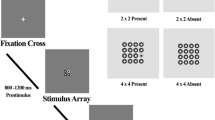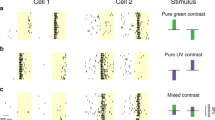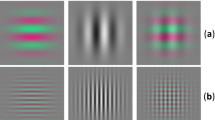Abstract
We have compared visual search under conditions that tend to isolate the magnocellular, parvocellular and koniocellular channels of the human visual system. We used isoluminant red–green stimuli that do not modulate short-wavelength sensitive (SWS) cones to isolate the parvocellular pathway, isoluminant SWS-cone isolating stimuli to stimulate only the koniocellular system and addition of small luminance contrasts to selectively activate the magnocellular pathway. We found that in the case of conjunction search, where attentional resources were required, the red–green (parvocellular) system can use accompanying small luminance (magnocellular) signals to improve visual search. On the other hand, when using SWS-cone isolating stimuli to selectively stimulate the blue–yellow (koniocellular) system, addition of similar luminance signals did not increase the efficiency of the serial visual search. The results indicate that S-cone signals may be processed in a separate pathway that does not get converging inputs from the magnocellular pathway. This is unlike the case with the red–green opponent system, which functions more synergistically with the magnocellular system.


Similar content being viewed by others
References
Arguin M, Joanette Y, Cavanagh P (1993) Visual search for feature and conjunction targets with an attention deficit. J Cogn Neurosci 5:436–452
Bisley JW, Goldberg ME (2003) Neuronal activity in the lateral intraparietal area and spatial attention. Science 299:81–86
Brefczynski JA, DeYoe EA (1999) A physiological correlate of the ‘spotlight’ of visual attention. Nat Neurosci 2:370–374
Calkins DJ (2001) Seeing with S cones. Prog Retin Eye Res 20:255–287
Casagrande VA, Kaas JH (1994) The afferent, intrinsic and efferent connections of primary visual cortex in primates. In: Peters A, Rockland KS (eds) Primary visual cortex of primates. X. Plenum Press, New York, pp 201–259
Casagrande VA, Sary G, Royal D, Ruiz O (2005) On the impact of attention and motor planning on the lateral geniculate nucleus. Prog Brain Res 149:11–29
Chatterjee S, Callaway EM (2002) S cone contributions to the magnocellular visual pathway in macaque monkey. Neuron 35:1135–1146
Cheal M, Lyon DR (1992) Attention in visual search–multiple search classes. Percept Psychophys 52:113–138
Cheng A, Eysel UT, Vidyasagar TR (2004) The role of the magnocellular pathway in serial deployment of visual attention. Eur J Neurosci 20:2188–2192
Colby CL, Duhamel JR, Goldberg ME (1993) The analysis of visual space by the lateral intraparietal area of the monkey: the role of extraretinal signals. Prog Brain Res 95:307–316
Corbetta M, Shulman GL, Miezin FM, Petersen SF (1995) Superior parietal cortex activation during spatial attention shifts and visual feature conjunction. Science 270:802–805
Cottaris NP (2003) Artifacts in spatiochromatic stimuli due to variations in preretinal absorption and axial chromatic aberration: implications for color physiology. J Opt Soc Am A 20:1694–1713
Dacey DM (2000) Parallel pathways for spectral coding in primate retina. Annu Rev Neurosci 23:743–775
Dacey DM, Lee BB (1994) The ‘blue-on’ opponent pathway in primate retina originates from a distinct bistratified ganglion-cell type. Nature 367:731–735
Dreher B, Fukada Y, Rodieck RW (1976) Identification, classification and anatomical segregation of cells with X-like and Y-like properties in the lateral geniculate nucleus of old-world primates. J Physiol (Lond) 258:433–452
Downing CJ, Pinker S (1985) The spatial structure of visual attention. In: Posner MI, Marin OSM (eds) Mechanisms of attention: attention and performance XI. Erlbaum, Hillsdale, pp 171–187
Ferrera VP, Nealey TA, Maunsell JH (1994) Responses in macaque visual area V4 following inactivation of the parvocellular and magnocellular LGN pathways. J Neurosci 14:2080–2088
Gandhi SP, Heeger DJ, Boynton GM (2001) Spatial attention affects brain activity in human primary visual cortex. Proc Natl Acad Sci USA 96:3314–3319
Golz J, MacLeod DIA (2003) Colorimetry for CRT displays. J Opt Soc Am 20(5):769–781
Hendry SH, Reid RC (2001) The koniocellular pathway in primate vision. Annu Rev Neurosci 23:127–153
Hicks TP, Lee BB, Vidyasagar TR (1983) The responses of cells in the macaque lateral geniculate nucleus to sinusoidal gratings. J Physiol 337:183–200
Livingstone M, Hubel D (1988) Segregation of form, color, movement, and depth: anatomy, physiology, and perception. Science 240:740–749
Lynch JC, Mountcastle VB, Talbot WH, Yin TCT (1977) Parietal lobe mechanisms for directed visual attention. J Neurophysiol 40:362–389
Martin PR, White AJ, Goodchild AK, Wilder HD, Sefton AE (1997) Evidence that blue-on cells are part of the third geniculocortical pathway in primates. Eur J Neurosci 9:1536–1541
Morand S, Thut G, Peralta RG, Clarke S, Khateb A, Landis T, Michel CM (2000) Electrophysiologcal evidence for fast visual processing through the human koniocellular pathway when stimuli move. Cereb Cortex 10:817–825
Motter BC (1993) Focal attention produces spatially selective processing in visual cortical areas V1, V2 and V4 in the presence of competing stimuli. J Neurophysiol 70:909–919
Nassi JJ, Lyon DC, Callaway EM (2006) The parvocellular LGN provides a robust disynaptic input to the visual motion area MYT. Neuron 50:319–327
Posner MI, Snyder CRR, Davidson BJ (1980) Attention and the detection of signals. J Exp Psychol Gen 109:160–174
Saarinen J (1993) Abstract shifts of visual attention at fixation and away from fixation. Vision Res 33:1113–1117
Shafritz KM, Gore JC, Marois R (2002) The role of the parietal cortex in visual feature binding. Proc Natl Acad Sci USA 99:10917–10922
Shulman GL, Remington RW, McLean JP (1979) Moving attention through visual space. J Exp Psychol 5:522–526
Sincich LC, Park KF, Wohlgemuth MJ, Horton JC (2004) Bypassing V1: a direct geniculate input to area MT. Nat Neurosci 7:1123–1128
Smith VC, Pokorny J (1975) Spectral sensitivity of the foveal cone photopigments between 400 and 500 nm. Vision Res 15:161–171
Smith VC, Pokorny J (1996) The design and use of a cone chromaticity space: A tutorial. Color Res Appl 21:375–383
Solomon SG, White AJR, Martin PR (2002) Extraclassical receptive field properties of parvocellular, magnocellular, and koniocellular cells in the primate lateral geniculate nucleus. J Neurosci 22:338–349
Steinmetz MA, Constantinidis C (1995) Neurophysiological evidence for a role of posterior parietal cortex in redirecting visual attention. Cereb Cortex 5:448–456
Stockman A, Macleod DIA, Depriest DD (1991) The temporal properties of the human short-wave photoreceptors and their associated pathways. Vision Res 31(2):189–208
Stockman A, Sharpe LT (2000) Spectral sensitivities of the middle- and long-wavelength sensitive cones derived from measurements in observers of known genotype. Vision Res 40:1711–1737
Stockman A, MacLeod DIA, Johnson NE (1993) Spectral sensitivities of the human cones. J Opt Soc Am 10:2491–2521
Sun H, Smithson HE, Zaidi Q, Lee BB (2006) Specificity of cone inputs to macaque retinal ganglion cells. J Neurophysiol 95:837–849
Treisman A (1988) Features and objects: the fourteenth Bartlett memorial lecture. Q J Exp Psychol A 40:201–237
Treisman A, Gelade G (1980) A feature-intergration theory of attention. Cognit Psychol 12:97–136
Vidyasagar TR (1998) Gating of neuronal responses in macaque primary visual cortex by an attentional spotlight. Neuroreport 9:1947–1952
Vidyasagar TR (1999) A neuronal model of attentional spotlight: parietal guiding the temporal. Brain Res Rev 30:66–76
Vidyasagar TR (2001) From attentional gating in macaque primary visual cortex to dyslexia in humans. Prog Brain Res 134:297–312
Vidyasagar TR, Pammer K (1999) Impaired visual search in dyslexia relates to the role of the magnocellular pathway in attention. Neuroreport 10:1283–1287
Vidyasagar TR, Kulikowski JJ, Lipnicki DM, Dreher B (2002) Convergence of parvocellular and magnocellular information channels in the primary visual cortex of the macaque. Eur J Neurosci 16:945–956
Wiesel TN, Hubel DH (1966) Spatial and chromatic interactions in the lateral geniculate body of the rhesus monkey. J Neurophysiol 29:1115–1156
Wolfe JM (1994) Guided search 2.0: a revised model of visual search. Psychon Bull Rev 1:202–238
Wolfe JM (2003) Moving towards solutions to some enduring controversies in visual search. Trends Cogn Sci 7:70–76
Wyszecki G, Stiles WS (1982) Color science—concepts and methods, quantitative data and formulae. Wiley, New York
Zenger B, Fahle M (1997) Missed targets are more frequent than false alarms: a model for error rates in visual search. J Exp Psychol Hum Percept Perform 23:1783–1791
Acknowledgments
We thank the Australian National Health and Medical Research Council for support by way of a project grant to TRV, Drs. Paul Martin, Jason Forte and Larry Abel for helpful discussions and Mr. Eugene Duff and Mr. Pinate Aramsangrungroj for computer programming.
Author information
Authors and Affiliations
Corresponding author
Rights and permissions
About this article
Cite this article
Li, J.C.H., Sampson, G.P. & Vidyasagar, T.R. Interactions between luminance and colour channels in visual search and their relationship to parallel neural channels in vision. Exp Brain Res 176, 510–518 (2007). https://doi.org/10.1007/s00221-006-0773-3
Received:
Accepted:
Published:
Issue Date:
DOI: https://doi.org/10.1007/s00221-006-0773-3




